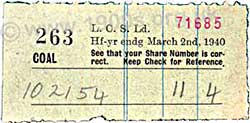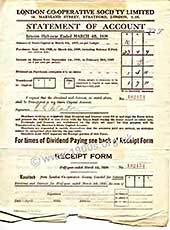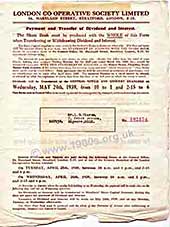Co-op dividend loyalty system, 1940s-50s UK

Co-op shops were extremely popular and widespread in Britain in the early 20th Century. Almost certainly this was due to customers receiving back a small percentage of what they spent in the form of what was called dividend. Dividend was extremely important to families as it provided additional income. This page comments of Co-op shops and goes on to what the dividend was, its importance to customers, how the shops handled it and how customers checked and collected it. Features are images of an actual Co-op sales chit from the 1940s and a customer copy of a late 1930s dividend statement.
____
By the webmaster based on her firsthand recollections and additional research with contributions from others who lived at the time
Everywhere a Co-op shop
Co-op shops seemed to be everywhere. There was a grocery one in Edgware, where my family lived, and in nearby Burnt Oak there was a large Co-op department store with goods that were extremely wide-ranging. My grandmother bought her shoes there, and I seem to remember my mother buying some clothes there.
Co-ops in the Birmingham area
contributed by Marilyn Ormson
A Co-op was always near enough to 'send the kids' with a list for bits and pieces. I used to get threepence or sixpence (old money) for my trouble from a neighbour to buy some sweets. That of course was after sweets came off ration in 1953. This was in the Birmingham area.
The country-wide Co-operative Wholesale Society
The various regional Co-ops were part of the larger Co-operative Wholesale Society CWS). The London branch, to which London Co-ops belonged, stood for the London Co-operative Society (CS). There would have been other names in other parts of the country. By working together, these Co-ops helped to keep their prices down.
Inside Co-ops
My recollections of the Edgware grocery Co-op - and even of the Co-op department store - are of a somewhat dark and dreary places. They were probably clean, but the decor did little to bear that out. So it was not surprising that my mother preferred Sainsbury's for fresh groceries. She was registered there during the rationing period, but that did not stop her shopping at the Co-op for off-ration non-perishable things. This was because of the dividend, an early form of loyalty card - see the following section.
The Co-op dividend
My mother used the Co-op for non-perishable and off-ration items because it rewarded customers by rewarding them in the form of what was called dividend. It was an early form of loyalty card, and I knew of no other sales outlet using anything similar until the Green Shield Stamp system of the late 1950s.
Customers had to register as what were called Co-op club members, and they then received a small percentage of the costs of their purchases back as dividend. This was also the case for my mother's own mother's patronage of early 1900s Co-op shops. It meant that families tended to shop in Co-ops by habit without much thought as to whether goods sold elsewhere might be cheaper. So Co-ops did good business.
Each club member had their own unique 'share' number. My mother's was 102154.

Co-op sales receipt chit found in the effects of my father and showing the family club number and the amount spent
At every sale, customers were given a chit, torn out from a sheet of blank ones, which was a receipt showing how much spent so that they could check the dividend that it had earned. However the chits were so tiny that many must have got lost. The page of chits had carbon paper underneath to give a record of the purchase for calculating dividend.
The amount of a dividend
contributed by Meryl Donaldson
From memory, dividend was about 2% or 3% of what the Co-op member spent. This would be paid out annually or biannually, and my mother, with kids in tow, had to walk up to the head office in town to receive her dividend in cash. This was in Scotland.
contributed by Meryl Donaldson
How families calculated the amount of the dividend
When the dividend was due, my older sister and I had to empty out our bag of receipt chits. Then we had to add them up so that my mother could work out her dividend. It was a huge task as there were hundreds of them. We usually did the sums in groups of twenty receipts at a time, writing the amounts in a column and then each of us would add it up separately. There were no calculators in those days. We then compared the totals to see if we agreed. When we didn't agree, we had to start over again. This was long before decimal currency of course, so the calculations were in pounds, shillings and pence which were more complicated to do.
The importance of keeping receipts
The dividend was hugely important to families. My mother received a fixed sum of weekly housekeeping money from my father, and the budget was tight. The dividend was therefore a vital extra.
On one memorable occasion my mother received more than she expected which sent her into a real rage with us kids. This was because we did most of the shopping and we were expected to remember to keep every receipt chit and put it in a special bag. Obviously we had lost some, which was considered almost criminal behaviour on our part.
Dividend statements
Below are images of my father's Co-op dividend statements for the half year ending 4th March 1939 - the only year's statement that has survived.
Tap/click for larger, legible images
How Co-op shops handled dividend
contributed by Meryl Donaldson
At the Co-op sales counter
The sales system was totally manual, and worked like this:
The shop assistant or cashier had a receipt book with pages that were perforated to produce the tear-off receipt chits, as shown in the above photo. The top copy was made from a very flimsy type of paper and was coloured yellow in our Co-op. There was a sheet of carbon paper and a duplicate page underneath.
The shop assistant would ask the customer for their Co-op number which she wrote on the chit along with the amount paid. If the item purchased was something expensive like a winter coat, this would also be written on the receipt chit. (The chit in the above image is marked for coal, a particularly expensive item.)
The cashier carefully tore off the top copy and gave it to the customer. The bottom copy was kept in the receipt book until the end of the day.
Inside the Co-op store office
The copies of the chits in their receipt books went to an office to be added up using a hand operated adding machine. This was a large clunky metal instrument with a lever on the side that was cranked after each entry. The money in the tills would then be counted to check that it agreed with the adding machine total. If it didn't, a staff member would be held to account and a shortfall often had to be repaid from their wages.
| sources | webmaster | contact |
Text and images are copyright
If you can add anything to this page or provide a photo, please contact me.





